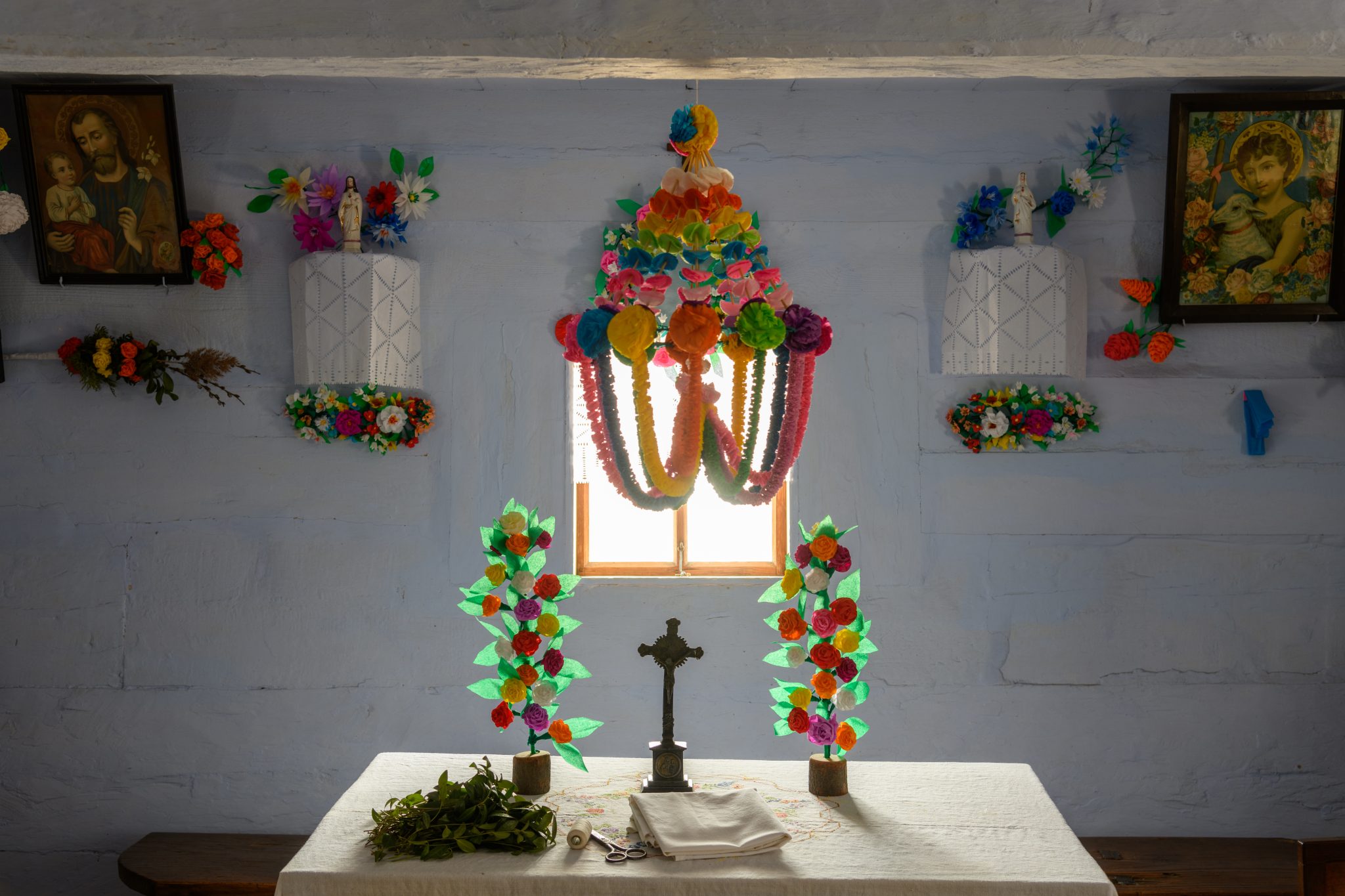EASTER EXPOSITIONS to be visited until 16th of April
We would like to invite you to visit the Lublin Open Air Village Museum during this extraordinary time of Easter. Some of our interiors have already been occasionally decorated, so they give us view for the rich rituals of Easter. In the manor from Żyrzyn, the rectory from Żeszczynka, cottages from Żukowo and Bukowa you will see special festive cakes and table set for a breakfast. In rural cottages there are Easter palms put behind holy images, home altars decorated with flowers made of colourful tissue paper, and so called „spiders” hanging from the ceiling – all these elements emphasize the solemn, festive character of the interiors and allow us to feel this outstanding atmosphere of the most important Christian feast. Elaborately created easter eggs were present both in rural cottages and landowners’ manors, mainly during the Holy Week. Visiting our Museum, you can compare the rich table sets in the rectory and the manor with the poor benches in the peasant’s room.
Easter decoration of compartment in Chałupa from Żukowo
In the cottage from Żuków in the Lublin Upland sector, you can see an early 20th century’s interior, decorated traditionally with a colourful „spider” hangs above the table, also pictures and home altars are decorated with flowers made of tissue paper. Moreover, decorative paper curtains cut out in geometric patterns and spruce twigs attached to the walls. On the bench, by the window, there are Easter baskets with eggs, bread, sausage, smoked ribs, salt in glasses, whetstones of butter, vinegar, rolls and horseradish. Under the bench there are potatoes in clay bowls, planted at the turn of April and May. There are three napkins on the table, next to them are periwinkles, a needle, white threads, and scissors.
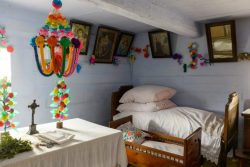
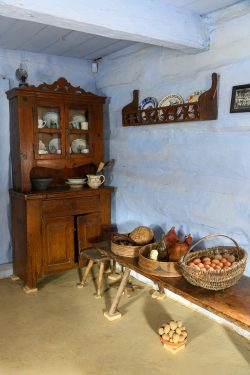
Easter decoration of compartment in Chałupa from Bukowa
In the cottage from Bukowa in the Roztocze sector, Easter breakfast was eaten on a bench placed centrally in the room, next to it were set the stools on peg legs. On the bench there is a clay bowl and 6 Easter eggs, five coloured in onions and one in green algae, another one with red borscht and wooden spoons – for a multi-generational family. On the wall, next to the pictures, there are pigeon-dolls made of blown eggs and aprons cut out of colorful tissue paper shaped like harmonica.
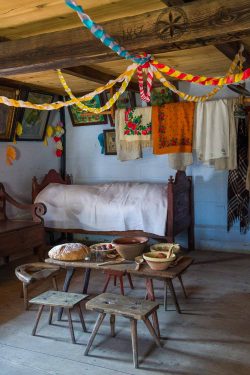
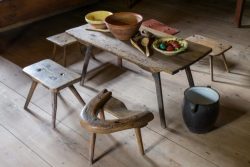
Dining room in manor from Żyrzyn
In landowners’ manors, Easter basket were placed on a separate table in the dining room, library, or even in a outhouse where it was cooler. On Holy Saturday’s morning, special car was sent to bring the priest to bless the food. In front of the manor, gathered estate’s employees and residents of nearby villages were waiting for the priest with their baskets.
In a manor, a table covered with a white tablecloth was decorated with branches of boxwood, periwinkle, and, if Easter was late, also with pieces of lycopods. ”In my childhood and youth, each manor had its own way what was on the table and in which quantity – recalled Zbigniew Janisławski (born 1922) from Wola Zółkiewska. The fact that something was or wasn’t there in our home didn’t mean that it was everywhere like that. Our table was heavily decorated with periwinkle and lycopods. In the middle was placed a large lamb, sometimes made of butter, sometimes made of dough or sugar. We were placing the lamb on greens, mostly cress. Next to them there were usually two ¾-cubit high cakes, not iced, and also pound cake with icing and mazurkas. Correctly, there should be 12 of them, as many as apostles. We had several types of mazurkas, one royal, one gypsy, one dried fruit with orange peels, and also a mazurka cheesecake. Mazurkas were placed on wooden stands-boards covered with notched paper napkins. There was a ring of sausage in the bowl, got eggs right and a branch of periwinkle stuck in it. There was ham on a platter, grated creamed horseradish, a whetstone of butter on a plate and salt in a crystal salt shaker. Once upon a time, but quite rarely before the war, there was served roasted piglet or a wild boar’s head with snout filled with stuffing an horseradish root. Easter basket had to include eggs. Neka, my nanny, was making Easter eggs in Wola. She had special felt tip and wax. We were helping Neka to make Easter eggs and we were using various patterns that were coming into our minds. They were Easter eggs made of wax, three colours at most. The main colour was onion or light pink from the bark of apple trees. Other colours were made of chemical powders and dyes, which were also ready for use at that time. In Wola Żółkiewska food, blessed on Holy Saturday, was lying on the table from that day and throughout the first Easter day. Easter breakfast on Holy Sunday began with sharing an Easter egg, next to it were hams, stuffed eggs, and most of the dishes were bringing from the kitchen. Easter eggs were eaten just on Holy Saturday.
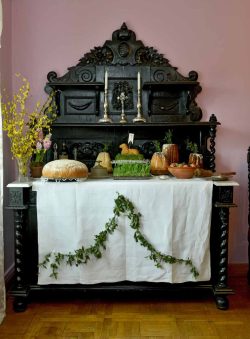
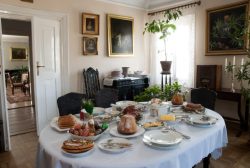
A table with a blessed food in rectory from Żeszczynka
In the rectory, just like in the manors, food to be blessed was preparing during all the week before Christmas. Lent lasted for six weeks, during which people fasted properly, according to the rules. The meals were free of animal fats and dairy products. Only one meal enough to fill you up per day was allowed. Consecrated food was religious symbol for the manor’s inhabitants, for those residing in the rectory or for the peasant family. It was thought to ensure health, prosperity, abundance and fertility for household. For the rectory’s residents, food was available all the year, but for the most of polish society, peasants, Easter was just a special ceremonial break from overcoming the hardships of the pre-harvest season.
A lamb made of butter, dough or sugar is a symbol of the Risen Christ, the beaten Evil, the victory of life over death. An egg to the beginning of a new rebirth of life. Bread is a symbol of the body of Christ, food for souls and human food. Salt protects against spoilage and has cleansing properties. Meat dishes mean material prosperity, health and fertility. Cheese means relationships between man and nature, it was thought to increase the animal livestock. Pound cake hasa t least five centuries of tradition in our country. It is a symbol of abundance and also expresses skills and perfection. Green branches on the Easter table symbolize resurrection and the reborn world of nature.
Some of Easter dishes were prepared in zoomorphic forms, made of clay, metal or cast iron. The adoption of such shapes emphasized the relationship between man and nature and referred to the landscape and symbolism of early Christian times.
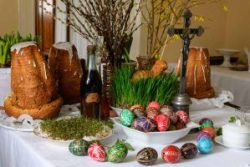
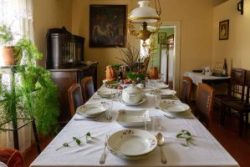
Kategorie: News | Data dodania: 5 April 2023
